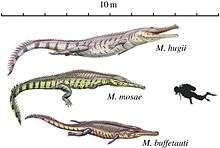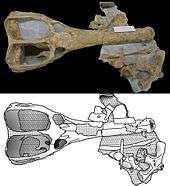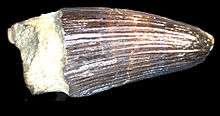Machimosaurus
| Machimosaurus Temporal range: 154–130 Ma | |
|---|---|
 | |
| Machimosaurus sp. fossil | |
| Scientific classification | |
| Kingdom: | Animalia |
| Phylum: | Chordata |
| Class: | Sauropsida |
| Infraclass: | Archosauromorpha |
| (unranked): | Mesoeucrocodylia |
| Suborder: | Thalattosuchia |
| Family: | Teleosauridae |
| Genus: | Machimosaurus Von Meyer, 1837 |
| Species | |
Machimosaurus is an extinct genus of teleosaurid crocodyliform from the Late Jurassic (Kimmeridgian and Tithonian) and Early Cretaceous.[2][3] The type species, Machimosaurus hugii, was found in Switzerland. Other fossils have been found in England, France, Germany, Portugal, Switzerland and Tunisia.[2][4][5] Machimosaurus was not only both the largest teleosaurid and thalattosuchian, but with a length of 9.6 metres (skull length 155 cm), it was the largest crocodyliform of the Jurassic.[3][2][4]
Discovery and species

Christian Erich Hermann von Meyer in 1837 named isolated conical, blunt teeth with numerous longitudinal lines from Switzerland, Madrimosaurus hugii. However, in 1838, realising he had misspelled the name, he emended Madrimosaurus to Machimosaurus,[6] from Greek makhimos 'fit or ready for war'. The teeth of Machimosaurus, with their rounded, blunt apex and stout morphology make them characteristic and easily identifiable compared to other teleosaurid teeth.[7]
The type species, M. hugii, is known from the Kimmeridgian of Portugal, Spain, Tunisia and Switzerland.[2][6] Machimosaurus ferox and M. interruptus were previously considered junior synonyms of M. hugii,[8][9] but have been recently considered possible synonyms of Machimosaurus mosae.[6]
Krebs (1967),[8] considered M. mosae (Lienard, 1876) to be a junior synonym of M. hugii, but is considered a second valid species of the genus based on a nearly complete skeleton found from the late Kimmeridgian of France.[6][10]
Two species also placed within Machimosaurus are M. bathonicus and M. rigauxi, from the Bathonian of France.[11] However, these are gracile species, lacking the characteristic blunted teeth of Machimosaurus, and are probably referable to Steneosaurus.[6]

Mark Young and his colleagues [6][12] made a detailed revision of the genus and recognized four species: M. hugii, M. mosae, M. nowackianus from Harrar, Ethiopia, and a new species, Machimosaurus buffetauti. They hypothesized that Machimosaurus may have been analogous to the Pliocene–Holocene genus Crocodylus in having one large-bodied taxon suited to traversing marine barriers and additional, geographically limited taxa across its range.
The fossilized anterior portion of the lower jaw from the Late Jurassic (Oxfordian or Kimmeridgian) of Ethiopia referred to the pliosaur Simolestes nowackianus, is in fact a large species of Machimosaurus.[13]
In 2016, a new species of Machimosaurus discovered in Tunisia was described in the journal Cretaceous Research. Named Machimosaurus rex, it is currently the largest teleosaurid known, estimated to be 9.6 m (31.5 ft) in length (skull length 155 cm (61 in)) based on a partial skeleton.[3][2] M. rex also stands at present as the youngest teleosaurid, hailing from the Early Cretaceous. However, more recent estimates put M. rex along with M. hugii at around 6.9–7.15 m (22.6–23.5 ft) long.[14] The discovery of M. rex indicates that teleosaurid crocodylomorphs survived the extinction event at the end of the Late Jurassic, but did not retain the diversity of species within their family from earlier periods. Further examination of the specimen revealed it was likely a generalist hunter due to its stocky, relatively short, and rounded teeth.[3][2]
Palaeobiology
Niche partitioning
From the Kimmeridgian-age, semi-aquatic deposits of Oker, Lower Saxony, Germany two genera of teleosaurids (Steneosaurus and Machimosaurus) are known, in addition to the neosuchian genera Goniopholis and Theriosuchus.[15] Machimosaurus and Steneosaurus are also found together in the same Tithonian-age deposits of western France.[16]
Diet

Bite marks on an early Kimmeridgian sauropod (Cetiosauriscus) femur from Switzerland match teeth known from Machimosaurus hugii, also found in the same deposits. This suggests either scavenging on the sauropod's corpse, or active predation from the waters edge, much like living crocodilians.[17] Kimmeridgian-age fossil turtles from "Solothurn Turtle Limestone" of northern Switzerland have bite marks, and splintered Machimosaurus teeth imbedded,[18] while fossil turtles from the Late Jurassic of Germany also possess bite marks that match teeth of Machimosaurus found in the same deposit.[19]
Morphofunctional analysis on the skull of Machimosaurus strongly suggests they eat turtles (chelonophagy).[8][9] Morphological comparison of their teeth also confirms that they are adapted to seizing and crushing hard prey.[7][20]
Locomotion
Based on the vertebrae (zygapophysial) articulations, Machimosaurus is considered to have lived in open-seas, swimming by lateral undulations of the tail with the limbs used for steering and balancing. Head and neck depressing (downward moving) muscles would have been well-developed, as their attachment site on the skull (basioccipital tubera) were large. This would have greatly assisted Machimosaurus in diving.[8]
See also
References
- ↑ Federico Fanti, Tetsuto Miyashita, Luigi Cantelli, Fawsi Mnasri, Jihed Dridi, Michela Contessi, Andrea Cau. The largest thalattosuchian (Crocodylomorpha) supports teleosaurid survival across the Jurassic-Cretaceous boundary, Cretaceous Research, Available online 10 January 2016.
- 1 2 3 4 5 6 http://news.nationalgeographic.com/2016/01/160111-ancient-crocodile-marine-largest-paleontology/
- 1 2 3 4 "The largest thalattosuchian (Crocodylomorpha) supports teleosaurid survival across the Jurassic-Cretaceous boundary". Cretaceous Research. 61: 263–274. doi:10.1016/j.cretres.2015.11.011.
- 1 2 Steel R. 1973. Crocodylia. Handbuch der Paläoherpetologie, Teil 16. Stuttgart: Gustav Fischer Verlag,116 pp.
- ↑ Mateus, O. 2013. Crocodylomorphs from the Mesozoic of Portugal and a new skull of eusuchian from the Late Cretaceous. Abstract book of Hwaseong International Dinosaurs Expedition Symposium, South Korea, pp: 66-68.
- 1 2 3 4 5 6 Young, M. T., Hua S., Steel L., Foffa D., Brusatte S. L., Thüring S., Mateus O., Ignacio-Ruiz Omeñaca J., Lepage Y., Havilk P., & Andrade M. B. (2014). Revision of the Late Jurassic teleosaurid genus Machimosaurus (Crocodylomorpha, Thalattosuchia). Royal Society Open Science. 1(140222), 1-42.
- 1 2 Vignaud, P (1997). "La morphologie dentaire des Thalattosuchia (Crocodylia, Mesosuchia)". Palaeovertebrata. 26 (1/4): 35–59.
- 1 2 3 4 Krebs, B (1967). "Der Jura-Krokodilier Machimosaurus H. v. Meyer". Paläontologische Zeitschrift. 41: 46–55. doi:10.1007/bf02998548.
- 1 2 Buffetaut, E (1982). "Le crocodilien Machimosaurus VON MEYER (Mesosuchia, Teleosauridae) dans le Kimmeridgien de l'Ain". Bulletin trimestrielle Société de la géologique Normandie et Amis du Museum, Havre. 69 (1/2): 17–27.
- ↑ Hua, S; Vasse, D; Buffetaut, E; Martin, M; Mazin, J-M; Vadet, A (1993). "Un squelette de Machimosaurus mosae Sauvage et Lienard, 1879 (Crocodylia, Thalattosuchia) dans le Kimméridgien du Boulonnais". Comptes rendus de l'Académie des sciences. Série 2, Mécanique, Physique, Chimie, Sciences de l'univers, Sciences de la Terre. 317 (6): 851–856.
- ↑ Sauvage, H-E (1874). "Mémoire sur les dinosauriens et les crocodiliens des terrains jurassiques de Boulogne-sur-Mer". Mémoires de la Société Géologique de France, série 2. 10 (2): 1–57.
- ↑ Young, M. T., Hua S., Steep L., Foffa D., Brusatte S. L., Thüring S., Mateus O., Ruiz-Omeñaca J. I., Havlik P., Lepage Y., & de Andrade M. B. (2015). Addendum to ‘Revision of the Late Jurassic teleosaurid genus Machimosaurus (Crocodylomorpha, Thalattosuchia)’. Royal Society Open Science. 2, , Number 2
- ↑ Bardet, N; Hua, S (1996). "Simolestes nowackianus HUENE, 1938 from the Late Jurassic of Ethiopia is a teleosaurid crocodile, not a pliosaur". Neues Jahrbuch für Geologie und Paläontologie Monatschefte. 1996: 65–71.
- ↑ http://palaeo-electronica.org/content/2016/1554-teleosaurid-size-estimation
- ↑ Karl H-V, Gröning E, Brauckmann C, Schwarz D, Knötschke N.2006. The Late Jurassic crocodiles of the Langenberg near Oker, Lower Saxony (Germany), and description of related materials (with remarks on the history of quarrying the "Langenberg Limestone" and "Obernkirchen Sandstone"). Clausthaler Geowissenschaften 5: 59-77.
- ↑ Billon-Bruyat J-P, Mazin J-M, Buffetaut E, Tong H, Abit D. 2001. New occurrence of vertebrate remains in the latest Jurassic of western France (Oléron island, Charente-Maritime). 6th European Workshop on Vertebrate Palaeontology - Florence and Montevarchi (Italy) - September 19–22, 2001 Abstract Booklet, p. 19
- ↑ Meyer, CA; Thüring, CR (2003). "Dinosaurs of Switzerland". Comptes Rendus Palevol. 2 (1): 103–117. doi:10.1016/s1631-0683(03)00005-8.
- ↑ Meyer, CA (1991). "Burial experiments with marine turtle carcasses and their paleoecological significance". PALAIOS. 6 (1): 89–96. doi:10.2307/3514956.
- ↑ Tichy, G; Karl, H-V (2004). "The structure of fossil teeth of chelonophagous crocodiles (Diapsida: Crocodylia)". Studia Geologica salmanticensia. 40: 115–124.
- ↑ Massare, JA (1987). "Tooth morphology and prey preference of Mesozoic marine reptiles". Journal of Vertebrate Paleontology. 7: 121–137. doi:10.1080/02724634.1987.10011647.